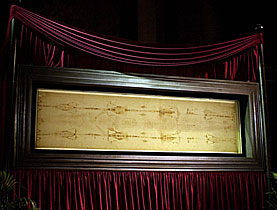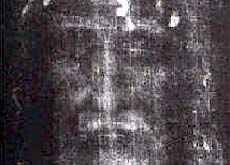Sacred relic still shrouded in mystery

The Shroud of Turin, one of the most sacred and mysterious relics of Christendom, may not be a medieval forgery after all, according to a new BBC film.
Internationally renowned Swiss textile conservator Mechthild Flury-Lemberg, who was interviewed for the film, always doubted the results the carbon-14 dating tests carried out on the shroud in 1988.
At that time three leading laboratories – in Oxford, Zurich and Arizona – concluded that the shroud must have been made between 1260 and 1390. New evidence from various sources suggest that it could go back to the first century.
The shroud is a long strip of linen which bears the imprint of the front and back of a human body. The traditional belief is that this is the grave cloth used to wrap the body of Christ after he was crucified.
But it has only been documented since the 14th century, when it turned up in France.
Carbon 14
“If it had been my decision I would never have done carbon-14 dating on the shroud,” Flury-Lemberg told swissinfo. The fact that the shroud has been exposed to its surroundings could have falsified the data, she explained.
Flury-Lemberg herself first came into close contact with the shroud in 2002 when she was asked to help conserve it. In the course of that work she made a very detailed analysis of the fabric which did nothing to change her mind.
The shroud suffered its greatest damage in 1532, when the chapel it was kept in caught fire, and drops of molten silver from the case which held it burnt large holes in the fabric. Nuns repaired the shroud by sewing it onto a backing cloth and placing patches over the holes.
These patches remained untouched for over 450 years until Flury-Lemberg and her assistant removed them. Underneath they found accumulated carbon dust, which had also got into the backing and into the fabric of the shroud itself as it had been rolled and unrolled over the centuries to be exhibited to the faithful.
She believes this dust could very well have skewed the data used in the carbon-14 tests.
She also points to the corner that was used for the tests, which was part of a water stain. “When the water runs over the textile it takes all the dirt with it. So at this corner you have the whole concentrated dirt. You can imagine that it was an extremely dirty sample, and also because at the corners of course people always held it,” she explained. “Therefore it made no sense to analyse this piece using carbon-14.”
Constantinople
It is one thing to cast doubt on the reliability of the test, but the textile historian is interested in clues that offer alternative hypotheses. For Flury-Lemberg, a manuscript from Constantinople known to date from the 1190s is a clear indication that the shroud was certainly in existence at the end of the 12th century.
“The painter of this document must have seen the Shroud of Turin and must have known it as the shroud of Christ,” she says.
The Pray codex, now in the Széchényi library in Budapest, shows the dead Christ on a strip of white linen. His arms are crossed, and only four fingers are visible.
“This is only on the shroud. The whole painting tradition puts the nail marks on the palms,” she points out. But in fact the nails used in the crucifixion would have been put through the wrists to hold the weight, forcing the thumbs inwards.
But the textile historian sees other indications that the subject of the illustration in the Pray codex is the item now known as the Turin shroud. One is the herringbone weave, a stylised version of which is clearly visible. The other is the pattern of L-shaped marks probably caused by oil soaking through many centuries ago when the cloth was folded.
“So you have two marks of the Turin Shroud. Marks which are very typical of the shroud in Turin are painted here. That’s the other reason why I never trusted the Oxford result.”
A similar herringbone pattern has been attested in weaving from long before the time of Christ. The seam that attaches a long strip along one side of the shroud is in a style that has been found on textiles found in the fortress of Masada in Israel which dates to around the beginning of the Christian era.
The impossibility of proof
But as a historian, she cannot give a hard and fast conclusion as to the age and origin of the shroud. “Of all the analyses we can make on the shroud, none speaks against an origin in the first century,” is as far as she can go.
Historians cannot produce certainties, as she points out. “The weave is possible for the first century. But people are not satisfied with this result. People don’t trust the historian because you don’t have results which you can measure. They only accept scientists. That’s a problem.”
She describes her work as helping to piece together a mosaic, although there will never be real proof. “There is no scientific proof for Jesus Christ,” she comments.
For Flury-Lemberg the fact that no one has been able to discover how the image of a man came to be on the shroud is another strong indication that it cannot be a 14th century forgery. If it cannot be reproduced today, it seems impossible that a forger could have placed it on the cloth seven centuries ago.
As far as the Vatican is concerned, the shroud is a devotional item for the faithful. Flury-Lemberg was under no pressure to authenticate it.
“They said: ‘If you can give the proof, try to find it. Until then, it’s an icon.’ For the Church it has the same importance if it is true or not.”
swissinfo, Julia Slater
The Turin Shroud is first documented in France in the 14th century. It may have reached there from Constantinople, which was sacked by crusaders in 1204.
It was repaired by nuns in Chambéry after a fire in 1532.
The shroud arrived in Turin in 1578 and has remained there ever since, although it belongs to the Pope.
Radiocarbon tests in 1988 purportedly showed the shroud to be a medieval forgery.
But no one has convincingly explained how a forger could have made the imprint of a body.
Later research, including investigations into the nature of the wounds, show that it is consistent with the grave cloth of a man crucified by the Romans.
Flury-Lemberg was born in Hamburg in 1929. After studying art history in Germany, she worked as a textile restorer first in Bavaria and then in Bern.
In 1963 she moved to the Abegg Foundation, a private textile collection near Bern, where she set up and headed the textile conservation workshop, which now enjoys an international reputation.
She retired in 1994.
In 2001-2 she was invited to head conservation work on the Turin Shroud.
Carbon-14 is a naturally occurring isotope used in radiocarbon dating.
Carbon-14 is spread through the atmosphere, and all living things exchange it with their surroundings until they die, when the exchange stops.
The amount of carbon-14 in the dead material then decreases at a known rate.
This decay can be measured to discover how long ago the material died.
Radiocarbon dating can only be used for organic material – including linen cloth, which is made from a plant.
Although the technique has been refined since it was first used in 1949, it includes a margin of error and outside influences may skew the results.

In compliance with the JTI standards
More: SWI swissinfo.ch certified by the Journalism Trust Initiative

You can find an overview of ongoing debates with our journalists here. Please join us!
If you want to start a conversation about a topic raised in this article or want to report factual errors, email us at english@swissinfo.ch.